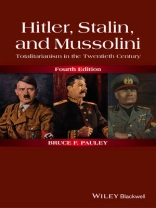The fourth edition of Hitler, Stalin, and Mussolini: Totalitarianism in the Twentieth Century presents an innovative comparison of the origins, development, and demise of the three forms of totalitarianism that emerged in twentieth-century Europe.
- Represents the only book that systematically compares all three infamous dictators of the twentieth century
- Provides the latest scholarship on the wartime goals of Hitler and Stalin as well as new information on the disintegration of the Soviet empire
- Compares the early lives of Hitler, Stalin, and Mussolini, their ideologies, rise to and consolidation of power, and the organization and workings of their dictatorships
- Features topics organized by themes rather than strictly chronologically
- Includes a wealth of visual material to support the text, as well as a thorough Bibliographical Essay compiled by the author
Tabella dei contenuti
List of Maps x
List of Plates xi
Preface xiii
1 The Ideological Foundations 1
Definitions of Totalitarianism 1
Marxism – Leninism – Stalinism 4
Fascism and Nazism 6
2 The Seizure of Power 12
Russia on the Eve of Revolution 13
The Establishment of the Soviet Dictatorship 16
The Failure of Liberal Italy 22
The Birth and Triumph of Fascism 26
Germany and the Impact of World War I 32
The Weimar Republic and the Rise of the Nazi Movement 38
The Great Depression and the Nazi Takeover 44
3 Personalities and Policies of the Dictators 51
Stalin’s Youth and Early Career 52
Stalin the Demigod 55
Mussolini: The Young Socialist 58
The Duce: Strengths and Weaknesses 63
The Young Hitler 65
Hitler: The Chaotic Dictator 69
Hitler’s Private Life and Relations with Women 73
4 Totalitarian Economies 77
The End of the New Economic Policy 78
Stalin’s War against the Peasants 80
The First Five-Year Plan and Industrialization 86
The Fascist Economy 89
The Economy of National Socialist Germany 94
5 Propaganda, Culture, and Education 102
The Limitations of Propaganda 103
Soviet Propaganda 105
Fascist Propaganda 107
Nazi Propaganda 109
Totalitarian Culture 114
Soviet Education 122
Education in the Fascist States 125
Youth Groups 128
6 Family Values and Health 134
The Conservative Trend in Values 135
Soviet Women: The Mixed Blessings of Emancipation 136
Fascist Italy: The Failure of Antifeminism 140
Women in Nazi Germany: Kinder, Kirche, und Küche? 144
Health and Eugenics in Nazi Germany 150
Religion: The Basic Incompatibility 153
7 Totalitarian Terror 162
The Great Purges in the Soviet Union 163
Terror and Persecution in the Fascist States 172
The Persecution of Jews 174
8 The Era of Traditional Diplomacy and War, 1933–1941 187
Hitler’s Foreign Policy Strategy 188
Hitler as “Peace Lover, ” 1933–1935 193
From Ethiopia to Spain: Fascist Italy at War 195
Austria and Czechoslovakia: Hitler’s First Conquests 200
The Approach of War 206
The Blitzkrieg Campaigns 210
The Italian Intervention 216
9 Total War, 1941–1945 223
Hitler Turns East 226
Stalin’s Preparations for War 229
The Russian Campaign in 1941 235
Hitler and the Untermenschen 238
Hitler and Stalin as War Lords 242
The Fall of Fascism 249
The German Home Front 253
The War in the West 256
The End of the Third Reich 260
10 The Collapse of Soviet Totalitarianism 266
Stalin’s Last Years, 1945–1953 267
The Khrushchev Era 271
Reaction and Reform: From Brezhnev to Gorbachev 275
Problems of the Soviet Economy and Society 279
Soviet Women in the Last Years of the Regime 282
Soviet Society in the 1980s: The Balance Sheet 285
The Revolt of the Satellites and the Disintegration of the Soviet Union 286
The End of Soviet Totalitarianism 289
11 Lessons and Prospects 292
The Triumph of Dogmatism 294
The Structural Flaws of Totalitarianism 295
The Totalitarian Legacy 300
Bibliographical Essay 308
Index 338
Circa l’autore
Bruce F. Pauley, Professor of History Emeritus at the University of Central Florida, is the author of six books on Nazism, anti-Semitism, totalitarianism, and the two world wars, as well as his autobiography, Pioneering History on Two Continents (2014).












